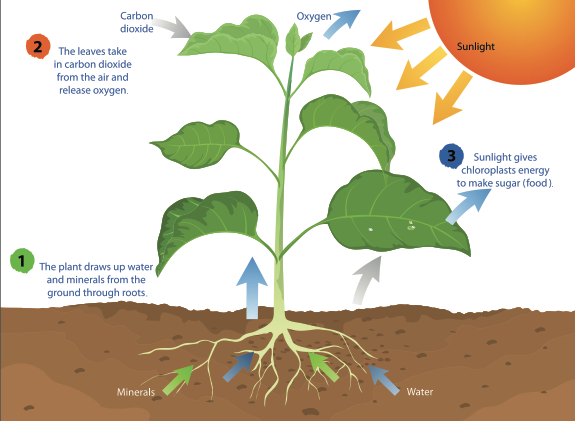What Is the Gas Given Off by Animals That Is Necessary for Plants to Make Food
When you get hungry, you grab a snack from your fridge or pantry. But what can plants do when they get hungry? You are probably aware that plants need sunlight, water, and a home (like soil) to grow, simply where do they get their food? They make it themselves!
Plants are called autotrophs because they can use energy from light to synthesize, or make, their own nutrient source. Many people believe they are "feeding" a plant when they put information technology in soil, h2o it, or identify it outside in the Sunday, but none of these things are considered food. Rather, plants employ sunlight, water, and the gases in the air to make glucose, which is a form of sugar that plants demand to survive. This process is called photosynthesis and is performed by all plants, algae, and fifty-fifty some microorganisms. To perform photosynthesis, plants need three things: carbon dioxide, water, and sunlight.
 Past taking in water (Water) through the roots, carbon dioxide (CO2) from the air, and light energy from the Sun, plants can perform photosynthesis to brand glucose (sugars) and oxygen (O2). CREDIT: mapichai/Shutterstock.com
Past taking in water (Water) through the roots, carbon dioxide (CO2) from the air, and light energy from the Sun, plants can perform photosynthesis to brand glucose (sugars) and oxygen (O2). CREDIT: mapichai/Shutterstock.com
Just like you lot, plants need to take in gases in social club to live. Animals take in gases through a process called respiration. During the respiration process, animals inhale all of the gases in the atmosphere, but the only gas that is retained and not immediately exhaled is oxygen. Plants, even so, accept in and utilize carbon dioxide gas
for photosynthesis. Carbon dioxide enters through tiny holes in a establish'south leaves, flowers, branches, stems, and roots. Plants also crave h2o to make their nutrient. Depending on the environment, a constitute's access to water will vary. For example, desert plants, like a cactus, take less bachelor water than a lilypad in a pond, but every photosynthetic organism has some sort of accommodation, or special construction, designed to collect water. For most plants, roots are responsible for absorbing water.
The concluding requirement for photosynthesis is an important one because information technology provides the energy to make sugar. How does a plant accept carbon dioxide and water molecules and make a food molecule? The Sunday! The energy from light causes a chemical reaction that breaks down the molecules of carbon dioxide and h2o and reorganizes them to make the carbohydrate (glucose) and oxygen gas. Afterward the sugar is produced, it is then broken down past the mitochondria into energy that can be used for growth and repair. The oxygen that is produced is released from the same tiny holes through which the carbon dioxide entered. Even the oxygen that is released serves another purpose. Other organisms, such as animals, employ oxygen to aid in their survival.
If we were to write a formula for photosynthesis, information technology would expect like this:
6CO2 + 6H2O + Light energy → C6H12Ovi (carbohydrate) + 6Otwo
The whole process of photosynthesis is a transfer of free energy from the Sun to a plant. In each carbohydrate molecule created, at that place is a little bit of the energy from the Dominicus, which the found can either apply or store for later.
Imagine a pea plant. If that pea institute is forming new pods, it requires a large amount of sugar energy to grow larger. This is similar to how you lot eat food to abound taller and stronger. But rather than going to the store and buying groceries, the pea plant will use sunlight to obtain the energy to build sugar. When the pea pods
are fully grown, the plant may no longer need as much sugar and will store it in its cells. A hungry rabbit comes along and decides to eat some of the establish, which provides the free energy that allows the rabbit to hop back to its dwelling. Where did the rabbit's energy come from? Consider the process of photosynthesis. With the assist of carbon dioxide and water, the pea pod used the energy from sunlight to construct the sugar molecules. When the rabbit ate the pea pod, it indirectly received energy from sunlight, which was stored in the saccharide molecules in the plant.
 We can thank photosynthesis for breadstuff! Wheat grains, like the ones pictured, are grown in huge fields. When they are harvested, they are ground into a powder that nosotros might recognize as flour. CREDIT: Elena Schweitzer/Shutterstock.com
We can thank photosynthesis for breadstuff! Wheat grains, like the ones pictured, are grown in huge fields. When they are harvested, they are ground into a powder that nosotros might recognize as flour. CREDIT: Elena Schweitzer/Shutterstock.com
Humans, other animals, fungi, and some microorganisms cannot make nutrient in their ain bodies like autotrophs, simply they still rely on photosynthesis. Through the transfer of energy from the Sun to plants, plants build sugars that humans swallow to drive our daily activities. Even when we eat things like craven or fish, we are transferring energy from the Sun into our bodies because, at some point, one organism consumed a photosynthetic organism (e.g., the fish ate algae). And then the next fourth dimension you grab a snack to replenish your energy, thank the Lord's day for it!
This is an extract from theStructure and Office unit of our curriculum product line, Scientific discipline and Technology Concepts TM (STC). Please visit our publisher, Carolina Biological, to larn more.
[BONUS FOR TEACHERS] Watch "Photosynthesis: Blinded past the Light" to explore educatee misconceptions about matter and free energy in photosynthesis and strategies for eliciting student ideas to address or build on them.
Source: https://ssec.si.edu/stemvisions-blog/what-photosynthesis
0 Response to "What Is the Gas Given Off by Animals That Is Necessary for Plants to Make Food"
Post a Comment